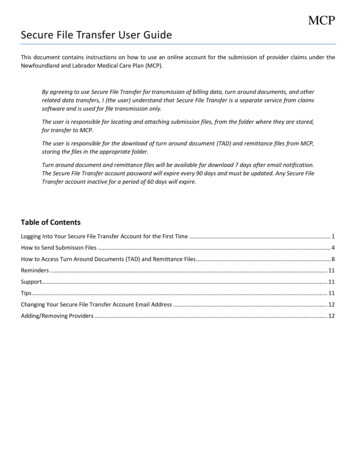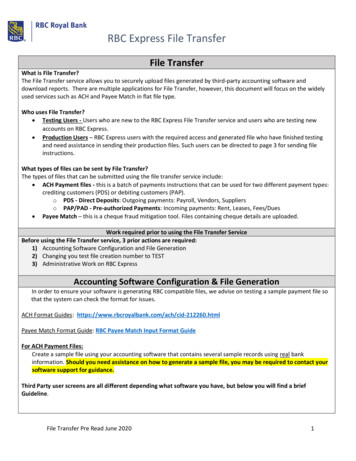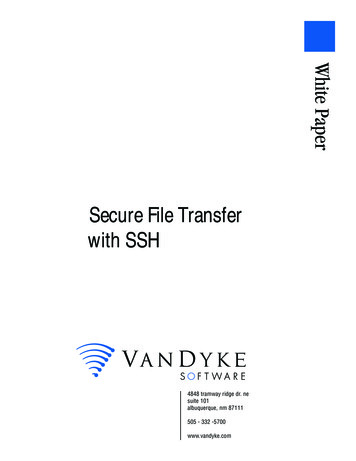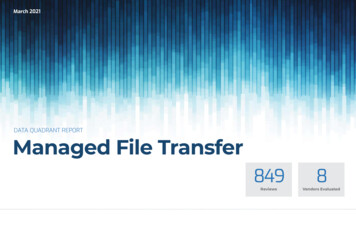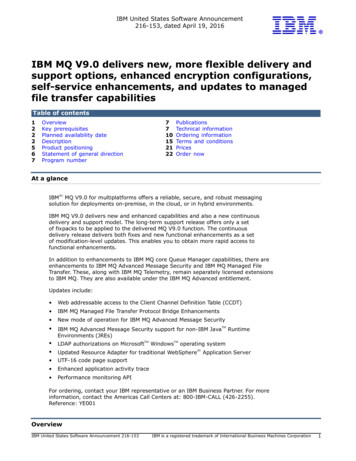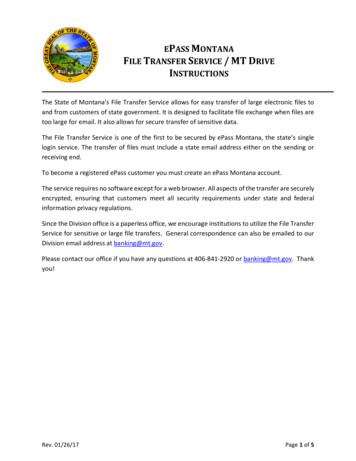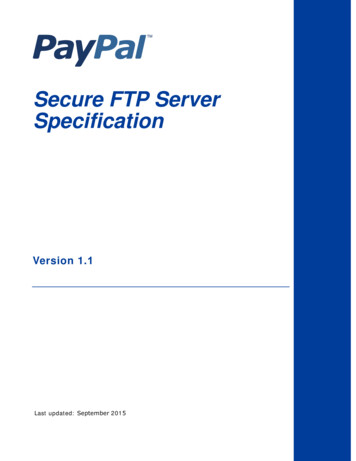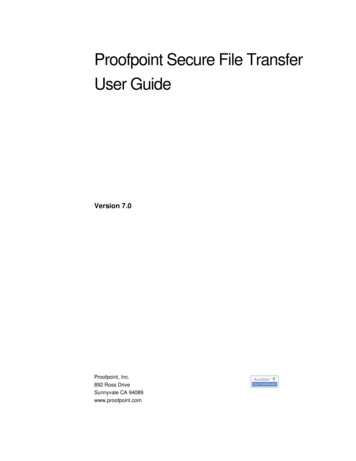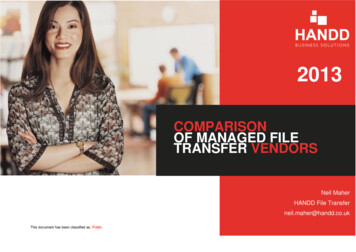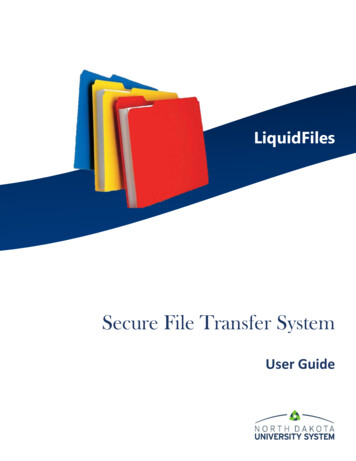
Transcription
LiquidFilesSecure File Transfer SystemUser Guide
Secure File Transfer System via EmailNDUS faculty, staff, and students have a new method for sending and receiving files containing sensitiveinformation or for sending and receiving files that exceed Outlooks file size limitation. LiquidFiles is asecure file transfer system for person-to-person email communication. LiquidFiles can be accessed intwo ways: online or through an installed Outlook plugin. Files can be shared securely with users inside oroutside the NDUS system. LiquidFiles works fast, just as you would expect with standard email.Accessing LiquidFiles Online1. Navigate to this URL: https://sendfiles.ndus.edu2. Use your IdM (identity management system) user ID and password to log in. Once logged in,your account will be created and you are ready to start using the application.NOTEIdM also refers to the same IDand password you use to loginto PeopleSoft, Financials,Campus Connection, andHRMS.NDUS CTS2 Page
Sending Files Using the Standard Compose Window from the Web142562371. Select recipients – type the recipients email address. LiquidFiles is not tied to any directoryinformation however your browser may remember previous email addresses. Address fieldsinclude: To, Cc, and Bcc.2. Type the Subject and Message to your recipients.3. Add Files, you can add files up to the max size displayed for your Group.4. Message expires after: by default, the maximum number of downloads per recipient is 2. There isno need to indicate a value in this field.5. Private Message — a Private Message is a message where the Message is not included in the emailsent to the recipients. When sending a Private Message: NDUS CTSThe recipients will get a generic email telling them to click on the link to view the message.You will get a read receipt when the recipient has viewed the message as well as when anyattachments has been downloaded.You can send a Private Message without any attachments.3 Page
It's not possible to send a Private Message with the permission that Anyone can download— in order to send a Private Message, authentication is required.6. Limitations – displays the maximum file size allowed in LiquidFiles. Clicking Blocked Extensionsproduces a list of file extensions that cannot be transmitted through LiquidFiles.7. When you're ready, click Send. As a sender, you will receive a receipt when your recipientsaccessed the secure attachments/private messages.How Recipients Retrieve FilesNDUS RecipientsWill log in using their IdM credentials (username and password) to access the link.External RecipientsSince external users do not have IdM credentials, they log in with their email address as their ID. Thisinitiates a validation code which is sent to their email account and makes the link accessible.BEST PRACTICELet external recipients knowwhat they can expect in themessage you send them.NDUS CTS4 Page
Requesting Files Using LiquidFiles OnlineLiquidFiles’ Request File option provides an easy way for you to request files from someone. There's noprior registration required and no need to walk someone through the process over the phone.To send a file request, make sure you have navigated to https://sendfiles.ndus.edu1. Click the gear icon located in the upper right corner of the page of the compose page.2. Choose Request File.123. Compose your message then click Request File.Optional: check “Send a Copy to Myself” if you wish to receive a copy of the message.3Clicking the Request File button delivers an email message with a unique File Request link. The email willlook something like this:NDUS CTS5 Page
When the user clicks the File Request link, they will be taken to a page that will look something like this:NOTEThe File Request link isone-time use only andwill expire once the fileshave been delivered.1. The recipient types their comments in the Message area,2. clicks the green Add Files button to attach the file,3. and when finished, clicks the blue Send button.NDUS CTS6 Page
Accessing LiquidFiles Using the Outlook PluginDownload the LiquidFiles Outlook plugin here: https://man.liquidfiles.com/clients/. Once the plugin isinstalled and enabled in Outlook, an additional Secure Attach tool appears at the end of the ribbonwhen creating a new message or replying.1234NOTEAdmin.exe is the recommended plugin to install.Contact your IT staff for assistance if you do not haveadmin rights to install this plugin.567The Secure Attach drop-down menu provides these options:1. Secure Attach — any file you would normally attach using the attach icon on Outlook can beattached using this Secure Attach button instead. This will cause any file attached to the email tobe sent using LiquidFiles.2. Attach Folder — you can also attach a folder at once and all files in this folder will be attachedto this email.3. Secure Attach All – this setting can automate that every Outlook attachment be sent throughLiquidFiles. This is not recommended.4. File Request —provides an easy way for you to request files from someone.5. Private Message — a Private Message is a message where the Message is not included in theemail sent to the recipients. See previous information.6. Select Existing Files — any file you've already sent that hasn't expired is available to send againwithout having to upload the file again.7. Options — settings for the plugin within Outlook. See section entitled “LiquidFiles OutlookPlugin Account Options” for more detailed information.NDUS CTS7 Page
Outlook Settings and ConfigurationThe first time you attach a file to LiquidFiles, you will see this login window:Verify or input the following information: Server: https://sendfiles.ndus.eduUser name: input your IdM username (firstname.lastname)Password: input your IdM PasswordPlease note that you only have to fill this in once. The LiquidFiles Outlook plugin will keep you logged ineven if you change your network password.LiquidFiles Outlook Plugin AccountOptionsThis section is for your information only. Thereis no need to change these settings. Logged in as: displays the currentlylogged in user.Logout – clicking this link will requireyou to reconfigure the connection.Online Help – click this link to accessLiquid Files online helpWindows Transfer Agent Options Max files to drop: this is the number offiles you can attach at once and howlong you want to see the window visible after you've sent the files.NDUS CTS8 Page
Keep file visible after they have been sent, ms: (ms refers to milliseconds)Outlook Plugin Options Add message to email: you can place the LiquidFiles Attachment information after yoursignature, placed below the body your email or at the top of it (please see the recipient email tosee how the attachment information looks).Upload Message Body Send the message using HTML, as plain text, or do not send any message through LiquidFiles. Automatic Send via Secure File Transfer for attachments of MB: As a default, Outlook’slimitation for attachments is 10 MB. This setting specifies that files exceeding the thresholdindicated will automatically be send via LiquidFiles.Who to Contact for SupportContact the NDUS Help Desk using any of these methods: Navigate your browser to: https://helpdesk.ndus.eduCall: 1-866-457-6387Email: ndus.helpdesk@ndus.eduNDUS CTS9 Page
Secure File Transfer System via Email NDUS faculty, staff, and students have a new method for sending and receiving files containing sensitive information or for sending and receiving files that exceed Outlooks file size limitation. LiquidFiles is a secure file transfer system for person-to-person email communication. LiquidFiles can be accessed in
